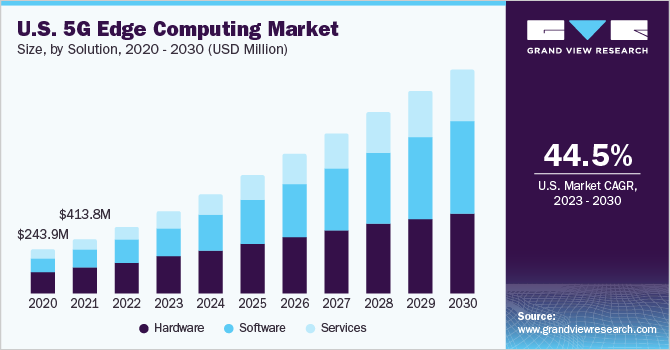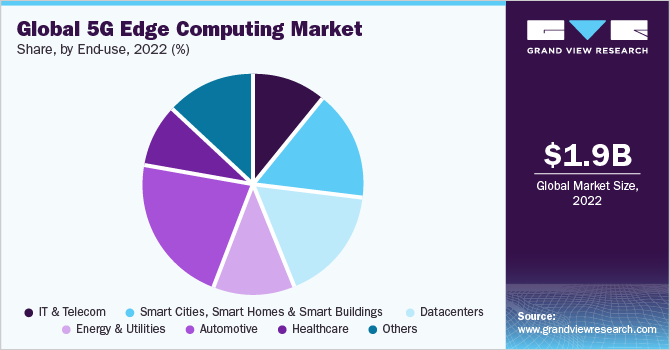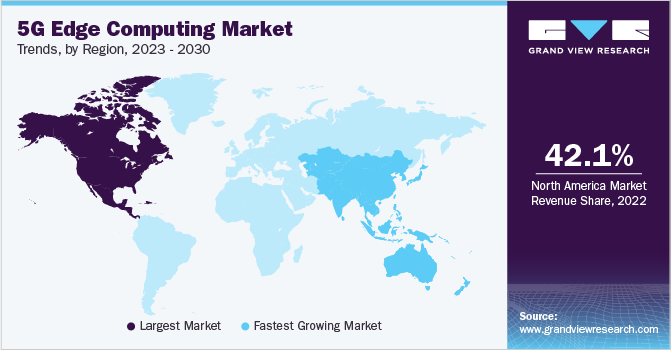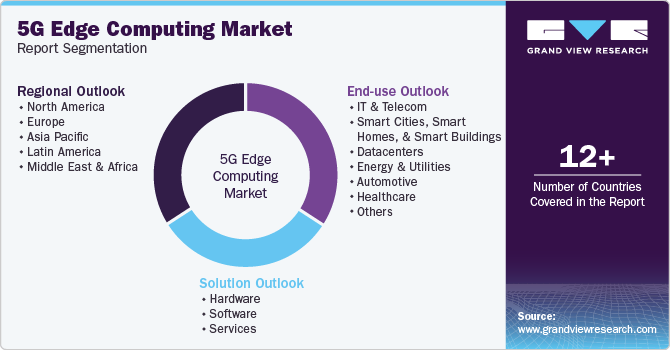- Home
- »
- Next Generation Technologies
- »
-
5G Edge Computing Market Size And Share Report, 2030GVR Report cover
![5G Edge Computing Market Size, Share & Trends Report]()
5G Edge Computing Market Size, Share & Trends Analysis Report By Solution (Hardware, Software, Services), By End-use (IT & Telecom, Smart Cities, Smart Homes, & Smart Buildings, Datacenters), By Region, And Segment Forecasts, 2023 - 2030
- Report ID: GVR-4-68040-110-7
- Number of Report Pages: 150
- Format: PDF, Horizon Databook
- Historical Range: 2018 - 2021
- Forecast Period: 2023 - 2030
- Industry: Technology
Report Overview
The global 5G edge computing market size was valued at USD 1.90 billion in 2022 and is expected to grow at a compound annual growth rate (CAGR) of 49.8% from 2023 to 2030. The market is expected to gain massive momentum in the coming years, considering the growing demand for the digital transformation of industries, with digitization being the foundation, network-based connectivity being the support, and industrial intelligence supporting the growth of the market. 5G edge computing refers to a distributed computing architecture that brings computation and storage capabilities closer to the end-users and devices, such as smartphones, IoT devices, and autonomous vehicles, with the integration of 5G connectivity. It addresses the increasing demand for low-latency, high-bandwidth, and high-reliability applications, such as augmented reality, virtual reality, gaming, and industrial automation, which is expected to drive the market growth over the forecast period.

The widespread adoption of cutting-edge technologies like the Internet of Things (IoT) and big data in sectors such as education, healthcare, manufacturing, and government has led to a significant surge in data generation. This trend has resulted in greater complexity in computing processes due to the handling of large data volumes. Furthermore, the increasing penetration of cloud services and IoT is expected to impact the industry’s growth over the forecast period positively. The key driving factors boosting the growth of software and devices include the growing need for real-time interaction with incoming data and the limitations of bandwidth availability. As a result, there is a growing necessity to efficiently manage and process the vast amounts of data generated by these technologies, which is driving the market growth over the forecast period.
5G edge computing utilizes the computing power of local devices like routers, smartphones, and PCs to achieve various advantages. It enables faster data processing and significantly reduced latency, leading to cost optimization and real-time information availability. The scalability of the technology allows it to efficiently adapt to specific contextual computing needs. As a result, enterprises are increasingly adopting 5G edge computing solutions to leverage these capabilities and enhance their operations.
The deployment of 5G edge computing across various application segments is expected to be closely linked to the usage of data-intensive applications, often relying on 5G connectivity. Several key parameters will shape the adoption of 5G in the future. Factors like cost, criticality of information, and speed requirements will influence how various industries leverage 5G to enhance their operations and provide better services to their customers. As the demand for data-intensive applications continues to grow and 5G networks become more prevalent, the significance of 5G edge computing in enabling real-time processing and reducing latency will likely drive its widespread adoption across diverse sectors.
Moreover, major players in the market are partnering and collaborating to increase awareness along with enhancing product development to cater to the growing demand for the technology. For instance, in February 2023, during MWC Barcelona 2023, Fujitsu showcased the advancements achieved through a series of connectivity trials conducted in collaboration with Microsoft Corporation. The main objective of these trials was to validate the seamless connectivity between Fujitsu's 5G network technology and Microsoft Azure private Multi-Access Edge Computing (MEC) infrastructure. Such collaborations are expected to propel the market growth over the forecast period.
Solution Insights
Based on the solution, the software segment dominated the market in 2022 with a revenue share of around 47% and is expected to grow at a CAGR of around 51% during the forecast period. The software provides a platform for virtualizing the network functions and services that run on edge servers. Virtualization software enables operators to deploy and manage virtualized network functions (VNF) at the edge, such as firewalls, load balancers, and content delivery networks, driving segment growth.
This software enables greater flexibility and scalability compared to hardware-based solutions, as VNFs can be easily deployed, scaled, and upgraded per the requirements. This software runs on edge servers and provides a platform for deploying and managing applications at the edge, and it enables developers to create and deploy applications that require low-latency and high-bandwidth connectivity, such as augmented reality, virtual reality, and gaming. Edge computing software solutions can also provide analytics and real-time processing capabilities for data generated by IoT devices, which is augmenting the segment growth further.
End-use Insights
Based on end-use, the IT & Telecom segment dominated the market in 2022 with a revenue share of 21.6% and is expected to grow at a significant rate over the forecast period. The telecom industry is a significant end-user of 5G edge computing, as it enables them to provide low-latency and high-bandwidth services to their customers. It allows telecom operators to move computing and storage closer to the end-users, enabling faster delivery of services. The IT industry is also increasing its adoption of 5G edge computing to provide better services to its customers. It enables IT service providers to deploy applications and services at the edge, enabling faster processing and analysis of data generated by IoT devices. Additionally, the technology can provide real-time analytics and insights, enabling IT service providers to deliver better services and user experiences. This, in turn, is expectedto fuel the segment growth over the forecast period.

The rising consumer demand for personalized and premium content, coupled with shifting lifestyle habits, has led to a substantial surge in content consumption through mobile devices. This generates large chunks of user data, which can be leveraged to analyze and offer a better-personalized experience. Moreover, the increasing proliferation of mobile devices and the need to cater to user demands are compelling service providers to enhance their network infrastructure. Additionally, the transmission of data from its source to the processing data center is affected by issues like packet loss, leading to bandwidth reduction. The adoption of mobile edge computing technology offers a solution to mitigate these challenges and optimize data processing at the network's edge. Such development is expected to drive the segment growth over the forecast period.
Regional Insights
North America accounted for the largest market share of more than 42.1% in 2022 as the region becomes one of the early adopters of the 5G network, and the number of IoT devices is expected to increase significantly. The U.S. is the region's largest market owing to major players in end-use industries. The telecommunication industry is a major contributor to the market's growth as technology is essential for end-users and consumers. The healthcare industry also plays a significant role in market growth as technology can provide faster and more accurate medical data analysis, leading to better patient outcomes, which is driving the expansion of the market in the region.

The Asia Pacific accounted for a sizable market share in 2022. The market across the region is likely to witness growth at a CAGR of 56.4% during the forecast period of 2023-2030. Companies in the region are providing solutions that integrate cloud computing with edge computing capabilities to enhance 5G edge computing architecture for commercial services. Furthermore, the region's significant development of the connected device ecosystem has resulted in a large amount of data being generated, demanding the need for a robust computational infrastructure, which is driving the 5G edge computing market growth in the region.
Key Companies & Market Share Insights
The market is classified as highly competitive, with the presence of several 5G edge computing industry players. The key players operating in the industry are focusing on strategic alliances, product development, expansion, and mergers & acquisitions to remain competitive in the industry. For instance, in June 2023, Hewlett Packard Enterprise (HPE) acquired Athonet, a leading private cellular networking specialist. This acquisition represents a significant step for HPE as it advances its mission to transform the private networking market, particularly by streamlining and expediting the implementation of private 5G networks.
The integration of Athonet allows the company to provide a complete and seamless solution for deploying the connected edge, enabling telecommunication companies to cater to the expanding market and empowering enterprises to embrace this transformative technology. Their all-encompassing suite of services, including Secure Access Service Edge (SASE), managed Wi-Fi, private 5G, and edge computing portfolios, ideally positions the organization to support and guide telcos and enterprises on their private networking ventures. Such mergers & acquisitions are anticipated to augment the market growth over the forecast period. Following are some of the major players in the 5G edge computing market:
-
ADLINK Technology Inc.
-
Advantech Co., Ltd.
-
Amazon Web Services, Inc.
-
Hewlett Packard Enterprise Development LP
-
Huawei Technologies Co., Ltd.
-
Juniper Networks, Inc.
-
Saguna Network Ltd.
-
EdgeConneX, Inc.
-
Johnson Controls International
-
Vapor IO
5G Edge Computing Market Report Scope
Report Attribute
Details
Market size value in 2023
USD 3.04 billion
Revenue forecast in 2030
USD 51.44 billion
Growth rate
CAGR of 49.8% from 2023 to 2030
Base year for estimation
2022
Historical data
2018 - 2021
Forecast period
2023 - 2030
Quantitative units
Revenue in USD billion and CAGR from 2023 to 2030
Report coverage
Revenue forecast, company ranking, competitive landscape, growth factors, trends
Segments covered
Solution, end-use, region
Regional scope
North America; Europe; Asia Pacific; Latin America; Middle East & Africa
Country scope
U.S.; Canada; Germany; U.K.; France; Italy; Spain; China; India; Japan; South Korea; Brazil; Mexico; Saudi Arabia; UAE
Key companies profiled
ADLINK Technology Inc.; Amazon Web Services, Inc.; Advantech Co., Ltd.; EdgeConneX, Inc.; Hewlett Packard Enterprise Development LP; Huawei Technologies Co., Ltd.; Juniper Networks Inc.; Saguna Network Ltd; Vapor IO; Johnson Controls International
Customization scope
Free report customization (equivalent to up to 8 analyst working days) with purchase. Addition or alteration to country, regional & segment scope.
Pricing and purchase options
Avail customized purchase options to meet your exact research needs. Explore purchase options
Global 5G Edge Computing Market Report Segmentation
This report forecasts revenue growth at global, regional, and country levels and provides an analysis of the latest industry trends in each of the sub-segments from 2018 to 2030. For the purpose of this study, Grand View Research has segmented the global 5G edge computing market report on the basis of solution, end-use, and region:

-
Solution Outlook (Revenue, USD Million, 2018 - 2030)
-
Hardware
-
Software
-
Services
-
-
End-use Outlook (Revenue, USD Million, 2018 - 2030)
-
IT & Telecom
-
Smart Cities, Smart Homes, and Smart Buildings
-
Datacenters
-
Energy & Utilities
-
Automotive
-
Healthcare
-
Others
-
-
Regional Outlook (Revenue, USD Million, 2018 - 2030)
-
North America
-
U.S.
-
Canada
-
-
Europe
-
Germany
-
U.K.
-
France
-
Italy
-
Spain
-
-
Asia Pacific
-
China
-
Japan
-
India
-
South Korea
-
-
Latin America
-
Brazil
-
Mexico
-
-
Middle East & Africa (MEA)
-
Saudi Arabia
-
UAE
-
-
Frequently Asked Questions About This Report
b. The global 5G edge computing market size was estimated at USD 1.90 billion in 2022 and is expected to reach USD 3.04 billion in 2023.
b. The global 5G edge computing market is expected to grow at a compound annual growth rate of 49.8% from 2023 to 2030 to reach USD 51.44 billion by 2030.
b. North America accounted for a revenue share of over 42% in 2022 in the global 5G edge computing market.
b. Some of the key players in the global 5G edge computing market include ADLINK Technology Inc., Advantech Co., Ltd., Amazon Web Services, Inc., Hewlett Packard Enterprise Development LP, Huawei Technologies Co., Ltd., Juniper Networks, Inc., Saguna Network Ltd., EdgeConneX, Inc., Johnson Controls International, Vapor IO.
b. Key factors driving the 5G edge computing market include increased adoption across industries, rise in the adoption of artificial intelligence and machine learning technologies, and their incorporation in edge hardware and software solutions.
Share this report with your colleague or friend.
![gvr icn]()
NEED A CUSTOM REPORT?
We can customize every report - free of charge - including purchasing stand-alone sections or country-level reports, as well as offer affordable discounts for start-ups & universities. Contact us now
![Certified Icon]()
We are GDPR and CCPA compliant! Your transaction & personal information is safe and secure. For more details, please read our privacy policy.
We are committed towards customer satisfaction, and quality service.
"The quality of research they have done for us has been excellent."





